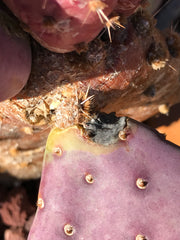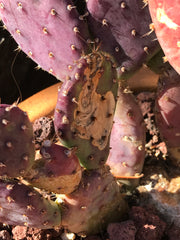Open up a pad of worms - identifying and dealing with cactus borrers
 There's this little ugly (IMO) worm that invades Opuntia species. It's commonly referred to as a 'Cactus borrer' and its the larval worm of a cactus moth (Cactoblastis cactorum). In some areas, like our local area, Opuntia grow so easily and quickly, they are considered weeds. They just go and go, up and over fences, down hills, onwards and onwards.
There's this little ugly (IMO) worm that invades Opuntia species. It's commonly referred to as a 'Cactus borrer' and its the larval worm of a cactus moth (Cactoblastis cactorum). In some areas, like our local area, Opuntia grow so easily and quickly, they are considered weeds. They just go and go, up and over fences, down hills, onwards and onwards.So, to people trying to control Opuntia, this little worm is a blessing. To cactus collectors and cactus lovers, like us, it's terrifying. Once it gets inside, it works very quickly and before long, your cactus is completely decimated.
These pictures are of my own personal Opuntia 'Santa Rita Baby'. We moved last year, I put her aside in a 'special' location and unfortunatly forgot to check on her frequently enough to catch this before it did serious damage. She was gorgeous before the worm got to her.

I should have noticed the worm had invaded sooner, and probably would have been able to save more of her pads. As it is, I'm using this as a learning experience for me and the opportunity to share with all of you signs of this pesky little worm.
Black holes are a sure sign of worm invasion. The worm only really needs one entrance and will eat its way up the inside of the cactus. You can still see signs of it, even if it didn't enter on that pad, because the eaten portions sink in and turn brown and black.
I've saved as many pads as possible, by twisting them off and then double-checking for any signs of worm infestation. I've seen the ugly little bugger a few times when pulling off an infested pad.

I am so sad to lose this favorite cactus of mine, but I'm hopeful the pads I was able to salvage will propogate easily.
What should you do if your Opuntia cactus shows sign of worm infestation?
Check for any undamaged and uninfested pads and remove them from the cactus. Then, bag that sucker (pot and all if possible) up and throw it away in the dumpster. You want to prevent the worm from invading any of your other plants and getting the infested cactus out of there is the best chance that it will not make it to your other plants.
Set the pads aside and ideally away from your other cactus. Check daily for any signs of infestation. Once a couple weeks have gone by, and the pads still look good and healthy, then it is safe to plant them.
Stick them in sand, preferably on a warm sunny day. Warm sunny days give cactus the best start. They will start to shoot out roots in 2-4 weeks. They will not need to be watered until they have a root system established.
Was this helpful? Let us know in the comments below.
More from:
Succulent Care










Leave a comment